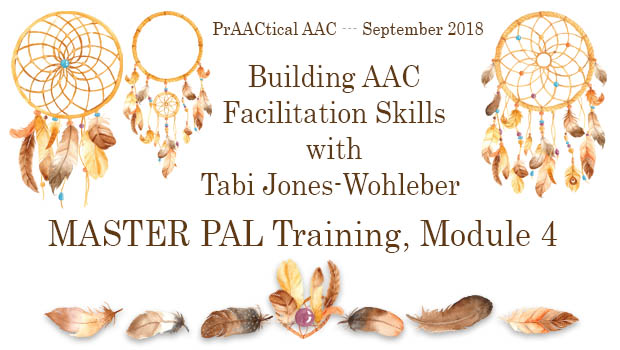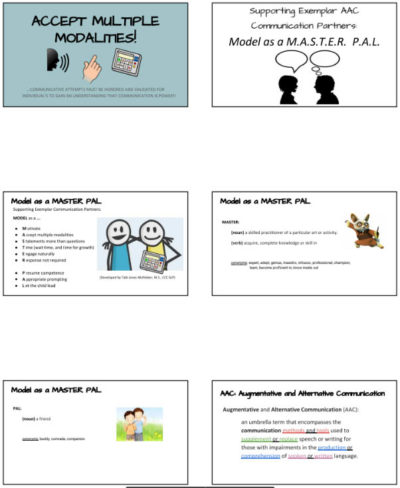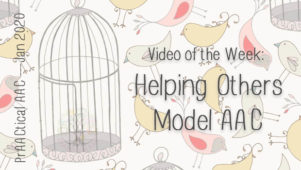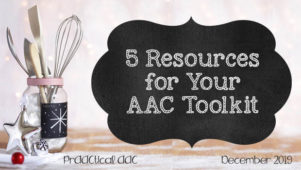Building AAC Facilitation Skills with Tabi Jones-Wohleber: MASTER PAL Training, Module 4

 Ready for more AAC training materials? In today’s post, Tabi Jones-Wohleber is sharing another module in the MASTER PAL series. This 30-minute session focuses on the role of multiple modalities in AAC.
Ready for more AAC training materials? In today’s post, Tabi Jones-Wohleber is sharing another module in the MASTER PAL series. This 30-minute session focuses on the role of multiple modalities in AAC.
::::::::::::::::::::::::::::::::::::::::::::::::::::::::::::::::::::::::::::::::::::::::::::::::::::
Model as a MASTER PAL
Module 4: Accept Multiple Modalities
Facilitator Guidelines
We all use multiple modalities to communicate…speech, text, email, a gesture, facial expressions. In much the same way we encourage young children to interact by assigning meaning to their gestures, expressions, and utterances, responding meaningfully to the communicative attempts of those who use AAC validates and encourages the effort. Honor all modalities and respond by modeling AAC as much as possible(regardless of the modality used by the PWUAAC) teaches AAC. Seize the opportunity to teach and expand language. After all, multi-modal communication shapes the human experience.
For this training you will need:
Warm-up Discussion:
| Thinking Prompt | Making Connections / Talking Points |
| How many ways do you communicate? -verbally -non-verbally -technologically |
Discuss how you communicate and why in various scenarios. For example, a “look” that you give your child in church or a quick text message to your spouse to pick up milk on their way home. |
| How do different communication modalities meet your different needs? |
Consider when you utilize texting vs. email vs. phone call vs. face to face communication. Describe how and why you vary communication with different people and situations. |
The Discourse:
| Topics Addressed | Slide(s) | Talking Points / Examples |
| Title Slides | 1-2 | N/A |
| Communication Review | 3-7 | Review of Model as a MASTER PAL and AAC to ensure all participants are on the same page |
| Introduction & Warm-up Discussion | 8-11 | Explained on Slides.
See chart above for Warm-up Discussion |
| Examples of modes of communication | 12-13 | Explained on Slides.
These are specific examples related to AAC from Warm-Up discussion. |
| Successful interactions involves many different modes of communication | 14-15 | It may not work to pull out the iPad during particular moments: sledding, swimming, at the beach, recess, field trips.
Consider alternative strategies that may be more efficient or durable, such as unaided or low-tech.
|
| Communication Partners can model on AAC even if the child uses a different modality | 16-18 | In order for an individual to understand the power of communication, all communicative attempts must be honored. But the onus is still on the communication partner to model their side of the interaction using the device. This teaches the child how to use their device regardless of the modality they choose at a given moment. |
| AAC Myths and Mythbusters | 19-22 | It is important to dispel myths related to use of AAC to ensure multiple modalities are honored.
Slide 19 – SNUG is an acronym often used to identify the goal for how a student uses AAC. But so often we hear “but he can talk”. This requires a reflective look at whether the child’s language is “SNUG”. |
| Let’s Re-Cap | 22 |
(developmentally, foreign languages, AAC, etc.).
|
Supplemental Handouts: Intro to Multi-Modal Communication
Video Links: NONE for this Module
Interactive Activities/Discussions
- Consider using low tech boards, communication apps, or device to play a game such as HeadBanz, Heads Up or Catch Phrase.
- Practice examples of home/school communication messages using varying levels of AAC. Participants can:
- Program messages onto single message buttons such as a Step by Step or Big Mack
- Make a remnant book to set the context and act as a conversational starter
- Program home and school messages on high-tech apps such as Proloquo2go, LAMP: Words for Life, or TouchChat.
Extension Resources
- AAC Language Lab – Pragmatics Profile (subscription needed)
- American Speech and Hearing Association – AAC Decisions (6 Points supporting SNUG):
- Assistiveware – Do’s and Don’ts of AAC – Multi-modal communication
- PrAACtical AAC
- The Baby, the Bathwater & Core Vocabulary
- Mining Preschool Routines for PrAACtical AAC Opportunities
- More on the use of multiple modalities here and here
- Project Core – Beginning Communicators
 ::::::::::::::::::::::::::::::::::::::::::::::::::::::::::::::::::::::::::::::::::::::::::::::::::::::::
::::::::::::::::::::::::::::::::::::::::::::::::::::::::::::::::::::::::::::::::::::::::::::::::::::::::
You can view the previous modules using the links below.
Filed under: Featured Posts, PrAACtical Thinking
Tagged With: AAC partner training, AAC Resources, Tabi Jones-Wohleber
This post was written by Carole Zangari




